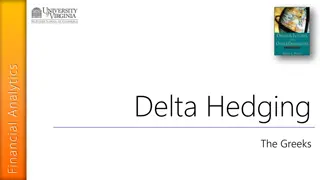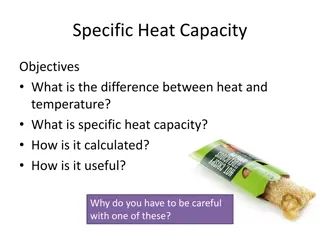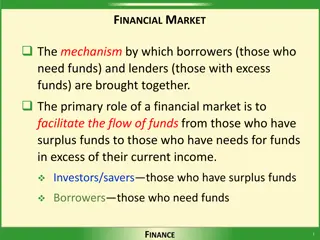Deep Hedging and Heat Rate Options: Enhancing Financial Markets
Explore the innovative concept of deep hedging and heat rate options introduced by Mark Higgins, focusing on improved hedging strategies through deep learning and optimization techniques. Discover the shift from traditional risk-neutral pricing to a more dynamic approach that utilizes neural networks to minimize risks and enhance portfolio management practices.
Download Presentation

Please find below an Image/Link to download the presentation.
The content on the website is provided AS IS for your information and personal use only. It may not be sold, licensed, or shared on other websites without obtaining consent from the author. Download presentation by click this link. If you encounter any issues during the download, it is possible that the publisher has removed the file from their server.
E N D
Presentation Transcript
Deep Hedging and Heat Rate Options Mark Higgins, Co-Founder & CAO The Future of Financial Markets on the Cloud
Overview: Better Hedging Through Deep Learning Introduction to deep hedging Gas-fired power plant optimization Heat rate options Comparison of deep hedging to risk neutral hedging
Introduction to Deep Hedging Paper by JPMorgan and academic partners in Feb 2018 https://arxiv.org/abs/1802.03042 Rethinks the core engine behind how to hedge a portfolio that generalizes beyond the assumptions behind traditional risk neutral pricing They focused on hedging vanilla options under a Heston stochastic volatility world In production at JPMorgan
Risk Neutral Pricing and Post-Hedges PNL Distribution Risk neutral pricing is the traditional approach to derivatives pricing and risk management but makes three important assumptions: No transaction costs when hedging Hedges are dynamically rebalanced continuously There are no unhedgeable risks If those assumptions are valid, PNL distribution over life of a deal is a delta function If they are violated, PNL distribution has some width If that happens, what are hedging objectives? Risk neutral processes: when simulating market prices for the purpose of derivative pricing, need to use a modified process so that expected value of a price in the future matches its market forward price
Deep Hedging to Go Beyond Risk Neutral First, decide what you want to optimize Convex risk measure of the post-hedges lifetime PNL distribution eg expected shortfall Assume that there s a nonlinear function which, given the market conditions and portfolio, tells you the new hedge trades to do In risk neutral pricing, that comes the sensitivity of the risk neutral price to market inputs In deep hedging, it s a neural network trained to minimize your convex risk measure
Benefits of Deep Hedging over Risk Neutral Pricing No need for risk neutral processes - all real world measure Reproduces standard risk neutral results in the limit of continuous hedging, no transaction costs, and no unhedgeable risks Can use any realistic market model you want that violates those risk neutral assumptions Transaction costs, infrequent hedging, unhedgeable risks Lots of real world applications, eg Life insurers issuing variable annuities Commodity traders managing physical assets
Example: Risk Neutral Limit Start with a simple case where we know the answer: delta hedging a short European call option with an underlying asset that follows geometric Brownian motion All risks are hedgeable, no transaction costs, frequent hedging Note that the asset process is the real world process, not risk neutral Example: 20% volatility, initial spot = 1, zero rates, zero drift, 3m to expiration, strike = 1 Should agree with Black-Scholes delta in this limit as all risk neutral assumptions hold
Example: Risk Neutral Limit Neural network structure: Neural network, two hidden layers, 50 nodes each Three inputs: current asset spot, current time, and current hedge notional One output: incremental notional of delta to trade on new hedge Training: Generate a subset of Monte Carlo paths (100 paths); each path has 20 time steps (so not exactly continuous rebalancing) At each time step on each path, ask the neural network for incremental hedge notional and add it to the portfolio Calculate the 70%-ile expected shortfall from the resulting PNL distribution Bump weights to minimize that expected shortfall Repeat 10k times until results are converged New set of 100 paths each time, so 1M paths overall
Example: Risk Neutral Limit As expected, reproduce the Black-Scholes delta Shown for four different calendar times approaching expiration Delta on y-axis, spot on x-axis; green is BS delta, blue is deep hedger
Example: Risk Neutral Limit Useful to look at histograms of realized PNL to understand better what the deep hedger does compared to the theoretical Black-Scholes limit Not continuous hedging this example has 20 time steps in 0.25y option lifetime so PNL distribution is not a delta function even in the Black-Scholes limit PNL distribution for a short option, so mean PNL is the negative of the risk neutral midmarket price of the option Blue bars are the deep hedger results, green are Black-Scholes Deep hedger PNLs have a slightly larger standard deviation but quite close to theoretical limit in this example
Extending to Transaction Costs Now we can move beyond risk neutral pricing using the same framework Add transaction costs Deep hedger tends to underhedge compared to risk neutral pricing
Extending to Proxy Hedges High transaction costs on underlying asset, but add a new zero transaction cost asset that is correlated with the underlying asset How much should you hedge with the liquid proxy? Red line: proxy; green: underlying; light blue: sum; blue, Black-Scholes Wider PNL distribution but smaller expected shortfall
Gas-Fired Power Plant Optimization Gas-fired power plant: buy and burn gas to generate and sell electricity Run it when power-gas spread is high, don t run it when it s not Acts like an option on the spread between power and gas prices If unhedged, revenue from the plant is volatile Volatile earnings are bad for company valuation Hedging gas and power price risks smooths out revenue profile In risk neutral limit, it makes revenue certain Good for company valuation Good example of a problem where risk neutral assumptions are violated Power and gas markets for delivery at the power plant are often illiquid and have high transaction costs Unhedgeable risks due to unexpected plant outages
Heat Rate Options Real world gas-fired power plants are complex and running them involves bespoke business risks Unexpected outages happen Turning a power plant completely off is expensive and difficult A heat rate option is a financial idealization of the spread option risk piece of a gas- fired power plant P(T) = power price G(T) = natural gas price H = heat rate - constant parameter K = spread strike - constant parameter
Heat Rate Options Hedge a heat rate option where both gas and power prices have high transaction costs, but both also have liquid correlated proxies Deep hedger (green) does much better than traditional risk neutral hedging (blue) Takes more risk but does better on upside and better on downside
Conclusions Deep hedging is a powerful new machine learning technique in derivatives pricing and risk management Deep hedging reproduces the results of risk neutral pricing when those assumptions are satisfied It that lets us extend quantitative hedging methods beyond the constraints of risk neutral pricing There are many problems of real option optimization in commodity markets where these techniques can perform better than previous state of the art























